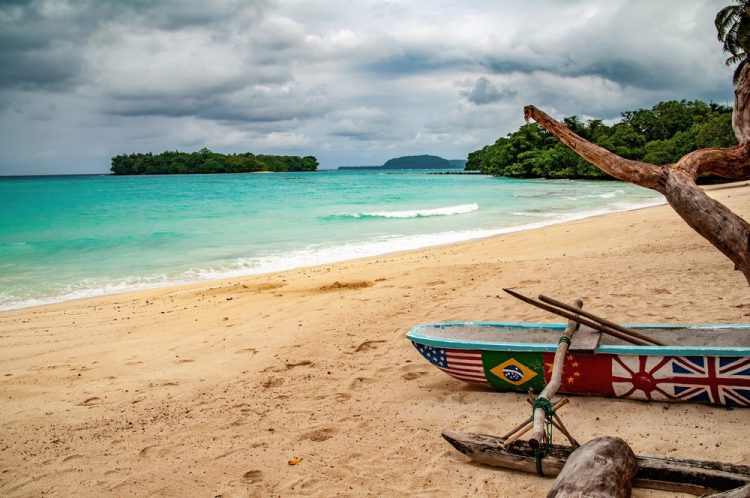Scattered across the waters of the South Pacific, Vanuatu is one of the world’s most captivating yet underexplored destinations. This Y-shaped archipelago of 83 islands offers visitors an authentic Melanesian experience wrapped in pristine natural beauty, active volcanoes, and some of the most culturally diverse communities on Earth.
Vanuatu lies approximately 1,080 miles east of northern Australia and 310 miles northeast of New Caledonia in the South Pacific Ocean. The nation stretches across roughly 800 miles of ocean, forming a distinctive Y-shape that extends from the Torres Islands in the north to Matthew and Hunter Islands in the south. Of its 83 islands, only about 65 are inhabited, with the largest being Espiritu Santo, Malakula, Efate, and Erromango.
The archipelago sits along the Pacific Ring of Fire, resulting in a landscape dominated by volcanic activity. Nine active volcanoes dot the islands, with Mount Yasur on Tanna Island being one of the world’s most accessible active volcanoes. The terrain varies dramatically from volcanic peaks and tropical rainforests to coral atolls and pristine beaches, creating a variety of ecosystems that support unique flora and fauna.
Long before European contact, Vanuatu was settled by Melanesian peoples around 3,000 years ago, followed by Polynesian influences. These early inhabitants developed sophisticated agricultural systems, complex social structures, and rich oral traditions that persist today. Archaeological evidence suggests continuous habitation and cultural evolution across millennia. European contact began in 1606 when Portuguese explorer Pedro Fernandes de Queirós landed on Espiritu Santo, believing he had found the southern continent. Captain James Cook later visited in 1774, naming the islands the New Hebrides. However, sustained European contact didn’t occur until the 19th century when missionaries, traders, and settlers arrived.
The colonial period proved tumultuous, with both Britain and France claiming territorial rights. This led to the unique arrangement of the New Hebrides Condominium in 1906, where both nations jointly administered the territory—a situation locals dubbed “the Pandemonium” due to its confusing dual legal systems, currencies, and languages. This period also saw the controversial practice of “blackbirding,” where Pacific Islanders were recruited, often through deception or force, to work on sugar plantations in Australia and Fiji.
Independence came on July 30, 1980, following growing nationalist movements led by figures like Father Walter Lini. The newly formed Republic of Vanuatu chose to align with the Non-Aligned Movement during the Cold War, establishing itself as a peaceful, independent Pacific nation.
Vanuatu possesses an extraordinary cultural diversity. With over 100 indigenous languages spoken across the islands—more languages per capita than anywhere else on Earth—each community maintains distinct traditions, customs, and beliefs. Bislama serves as the unifying lingua franca, blending English, French, and local languages into a colorful pidgin.
Traditional practices remain very much alive. The spectacular land diving ceremony on Pentecost Island, considered the original bungee jump, sees young men leap from 30-meter wooden towers with only vines attached to their ankles—a ritual to ensure a good yam harvest. Art and crafts reflect this cultural richness through intricate wood carvings, traditional pottery, and elaborate ceremonial masks. Music and dance vary dramatically between islands, from the water music of Gaua Island to the string band traditions influenced by missionary contact.
Vanuatu boasts a diverse range of wildlife, including unique birds and bats, fascinating marine life, and the impressive coconut crab. The islands are home to various endemic bird species, including the Vanuatu megapode and the Vanuatu kingfisher. Marine life is abundant, featuring colorful coral reefs, diverse fish species, and marine mammals, including dugongs, dolphins, and whales. While there are no indigenous large mammals, the islands are home to a variety of interesting reptiles, including several lizard species and the flowerpot snake.
Travelers seeking authentic experiences find Vanuatu irresistible for several reasons. The country offers unparalleled cultural immersion opportunities, from participating in traditional ceremonies to staying in custom villages. Adventure seekers are drawn to its active volcanoes, world-class diving sites, and pristine hiking trails through untouched rainforests. The islands boast some of the Pacific’s best diving, with World War II wrecks, including the famous SS President Coolidge on Espiritu Santo—the world’s largest accessible shipwreck. Coral reefs teem with marine life, while blue holes and underwater caves provide unique diving experiences. Kayaking is a popular activity among visitors, and freshwater swimming holes are maintained by villagers for recreational use. The Millennium Cave tour is an exciting point of interest, though somewhat physically challenging.
Temperatures typically range between 71 degrees Fahrenheit and 83 degrees. The dry season (May to October) represents peak travel time, offering the most reliable weather with minimal rainfall, comfortable temperatures, and lower humidity. This period sees higher visitor numbers and accommodation prices, particularly during July and August when Australian and New Zealand schools take winter holidays.
The shoulder seasons (April-May and October-November) provide excellent compromise options with fewer crowds, competitive prices, and generally good weather. April can still see occasional rainfall, while November marks the transition toward the wet season.
The wet season (December to March) presents the highest risk of cyclones and heavy rainfall, though it also offers the lowest prices, fewest crowds, and lush, green landscapes. This period suits budget-conscious travelers willing to accept weather unpredictability in exchange for authentic experiences and significant savings.

